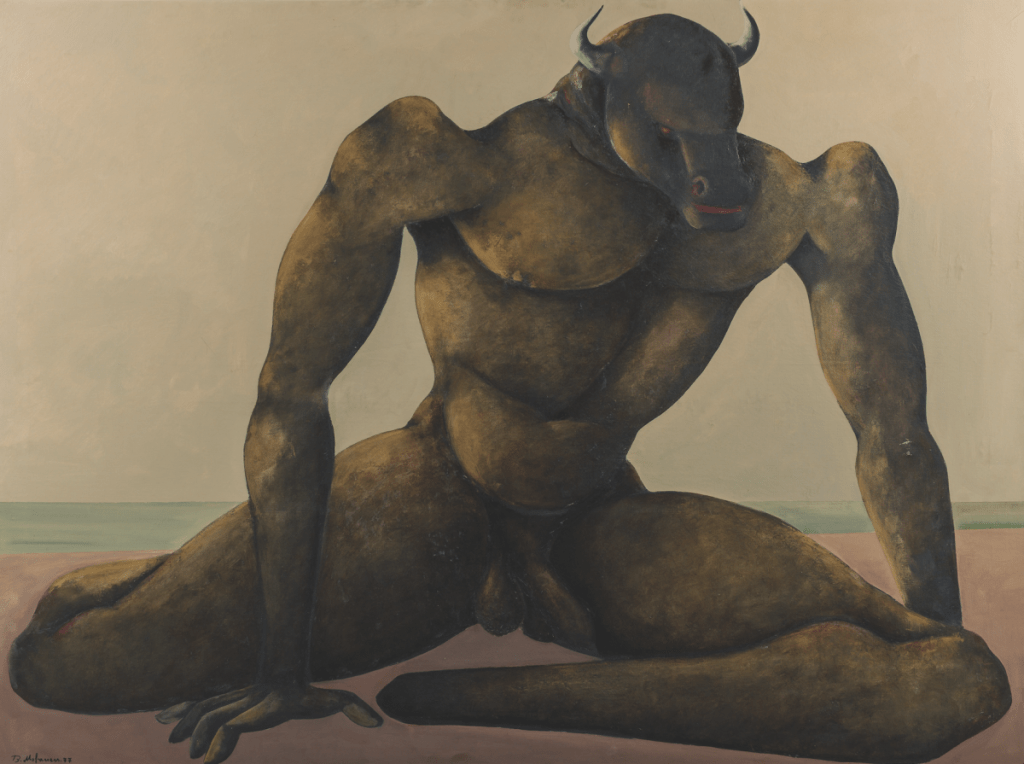Bahman Mohassess, the most outstanding modernist of Iran, was dubbed the “Persian Picasso”.But for nearly five decades of his career, he lived out of the public eye. In Italy, his compatriots thought he was dead.
Bahman Mohassess is best known for his paintings of anthropomorphic figures hinting at international political conflict. It took several years for the curators to turn their attention to Bahman Mohasses after his death at the age of 79 in 2010.
In 2014, the Iranian artist was included in The Unedited Story. This is an important study of Iranian contemporary art at the Musée d’Art Moderne de la Ville de Paris. That same year, London’s Tate Modern acquired a group of five 1966 gouache paintings depicting his signature sculptural faceless heads.
In 2017, long-unseen works by Bahman Mohassess from the permanent collection of the Tehran Museum of Modern Art were shown in the Iranian capital. There they appeared along with paintings by Francis Bacon.
Just a few weeks ago, Minotauro sulla Riva del mare (1977), depicting a naked, muscular man with the head of a mythical creature, sold for a record $ 1.4 million at Sotheby’s in London.
Bahman Mohassess has lived in Italy for most of his career. He probably never expected such recognition. Because he did not believe in promoting his work and made no attempt to solidify his legacy.

Living in Exile
Bahman Mohassess was born in 1931 in a city on the coast of the Caspian Sea. The Iranian artist began his art studies at a young age, enrolling in the Faculty of Fine Arts at Tehran University.
It was during this period that Bahman Mohassess became acquainted with the avant-garde art scene of the city. In 1954, at the age of 23, the artist moved to Italy to study at the Roman Academy of Arts.
The foundation of his career may have been laid in Iran. But his self-exile in Italy, where he studied European modernism, became defined in the development of his corporate identity.
When Bahman Mohassess first left Iran to study in Italy, it was a time of political change in the Middle East. He fled after the country’s democratically elected Prime Minister, Mohammad Mossadegh, attempted to nationalize the oil industry, undermining British control over it. Mossadegh was overthrown in 1953 in a military coup supported by the US and British secret services. The change of regime sparked massive protests and prompted some artists and intellectuals to leave.
Ashkan Baghestani, head of Sotheby’s sales and director of the Middle East and Contemporary Art, said Iran’s political priorities and cultural views drove Bahman Mohassess out of the market.
Iran to Italy and Back Again

When Bahman Mohassess moved permanently to Italy in the late 60s, he began to develop his artistic style, drawing on ideas from Pablo Picasso, Max Ernst, Henry Moore, Alberto Giacometti, and ancient Greek and Roman mythology. The figures in his paintings are compared to those of Francis Bacon, who, like Bahman Mohassess, was openly gay.
In 1963, the Iranian artist participated in the 3rd Paris Biennale and the 7th Biennale in Sao Paulo. Although Bahman Mohassess was now living in Italy, his work was still seen in his home country. The Shah and Empress Farah Diba commissioned him to work on public squares in Tehran, some of which were later demolished during the Islamic Revolution in 1979.
In Mitra Farahani’s 2014 documentary Fifi Howling with Happiness, which describes the last two months of the artist’s life, spent in his residence in a hotel in Rome, Bahman Mohasses recalls one such work, The Flutist, a large-scale sculpture with a nude male figure. play the flute set in the town square.
Former US Vice President Nelson Rockefeller, who developed close ties with the Shah of Iran in the early 1970s, acquired a 1968 Mohassess painting Personaggio I, which depicts a faceless stone bust on black and red ground.
Some of Bahman Mohassess’ most famous works no longer exist, and since later in his life he created works only for special commissions, his work is surrounded by many secrets.
What is known about the work of the Iranian artist is that it took him in new and strange directions and led to his further transition to sculpture. In the 1960s, Bahman Mohassess began working with the Bruni foundry in Italy. Later, Bruni’s son, Francesco, became the foundry and became a close friend of the Iranian artist.
He was ultimately tasked with storing a small handful of Bahman Mohassess’s remaining works, including some of the largest he has ever done.

No room for sentimentality or pity
Political strife is frequently mentioned in Bahman Mohassess’ works. Requiem Omnibus (1968), for example, was painted in response to the assassination of Martin Luther King Jr. and civil unrest in France under President Charles de Gaulle.

But instead of directly portraying these figures, Bahman Mohassess suggests to grayish people who seem to be struggling, their bodies painted in such a way that their skin looks like stone. These figures are reminiscent of the figures seen in Francis Bacon’s 1968 painting Figures Lying on a Bed with a Servant in the Tehran Museum of Modern Art.
In other his works, Bahman Mohassess has focused on animals that convey dark symbolism. He often returned to depicting a fish being thrown out of the water, which could be seen as a way to visualize his own alienation.
By the 1970s, disillusioned with his Iranian roots, Bahman Mohassess abandoned the Persian influences still present in his 1960s work and instead used erotic imagery and inspiration from European modernists. According to Baghestani, Bahman Mohassess did it without any remorse, any complexes, any taboos, and he will use the Minotaur as a central figure in many of his works.
Many surrealist painters – from Picasso and Dali to Magritte and Man Ray – were attracted to this mythical creature, seeing it as a symbol of the primordial nature of man. For Bahman Mohassess, the minotaur’s jaded psychology was an effective way to portray his personal and political divisions.
Various critics and historians associate the apparent masculinity of the Minotaur with the sexuality of Bahman Mohassess. In “Fifi Howls with Happiness,” he recalls his romantic relationship, which he had to conduct in secret.
Myth-Making

In the film, Farahani Bahman Mohassess refers to some items that he claims he destroyed without leaving anything to the scavengers.
These “dead” works include Minotauro sulla Riva del mare (1977) and Fiorella (1977), the latter of which depicts a young blonde woman licking a dripping ice cream cone, which some scholars believe contains sexual connotations.
In March 2021, it was revealed that these works are alive – they survived and remained in the care of the Bruni family for years before they were sold at auction. The Iranian artist left them with his family around 2006 when he made his last trip to Iran to take care of his dying brother.
Judging from the documentary, it is unclear whether Mohassess made false claims about his remaining work to subvert Farahani’s project, or whether these details were deliberately left ambiguous, but one thing is clear: Bahman Mohassess did not want to be rescued from obscurity.























